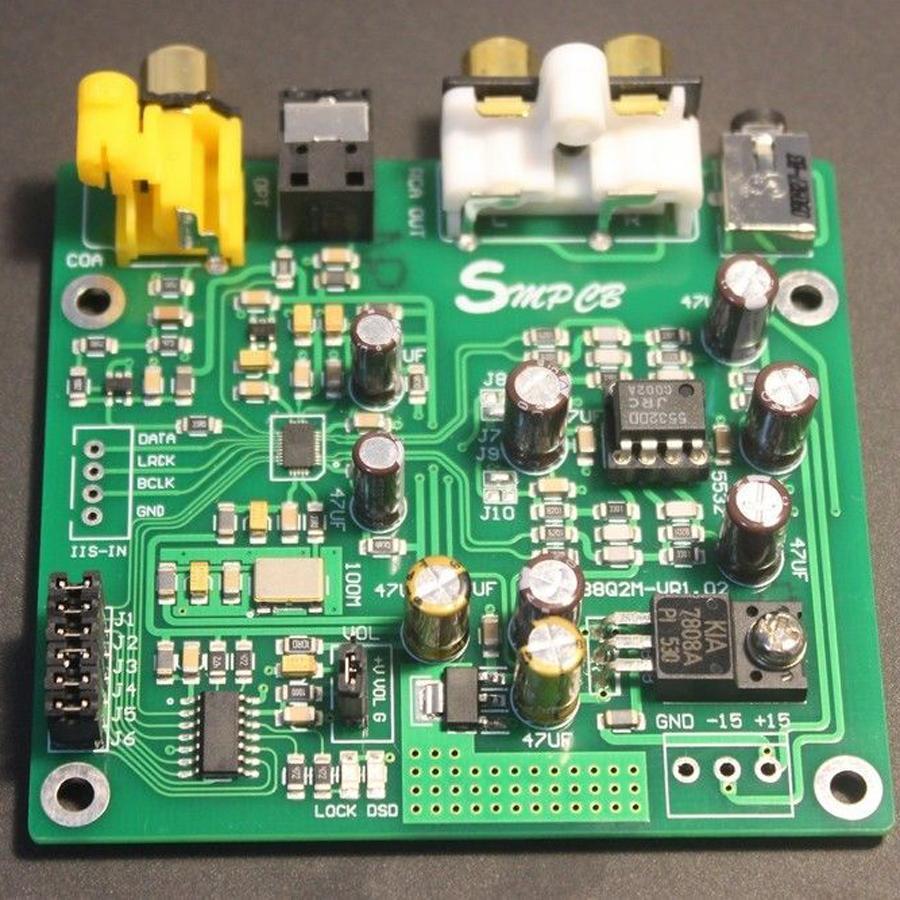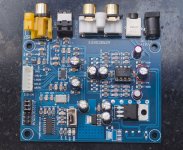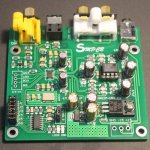I guess I don't understand what you mean then. The difference file between what and what? If you mean the new BT dac here, it is already in pieces. No way to record it in its original state.
Besides, it probably wouldn't be that useful. Both files might sound about the same if you played them on a dac that couldn't accurately reproduce the differences, especially the clean sound of a clean version. So, it just doesn't make sense to me however which way.
It seems like the only good way for you see what the big deal is would be if you could hear a very clean dac for yourself, and kind of looks like that may not be possible.
Besides, it probably wouldn't be that useful. Both files might sound about the same if you played them on a dac that couldn't accurately reproduce the differences, especially the clean sound of a clean version. So, it just doesn't make sense to me however which way.
It seems like the only good way for you see what the big deal is would be if you could hear a very clean dac for yourself, and kind of looks like that may not be possible.
Last edited:
The difference is obviously between modification states, an unmodified and a modified output recording. For example the original board and a final product or any intermediate step, like an additional board that alters the sound like the upsampler or just by changing opams or tubes. Anyway someone else might find it useful.
350 degrees I think, it's an older unit with no digital readout, just a knob.
I'll take a picture in the morning when there's daylight, it's just past midnight here.
I would think it would be possible to use some thin wire to connect to the trace on the board, the question is, can I do it, I'm not entirely convinced this screw up wasn't my fault, to err is human...
1. the particular bard is a knockoff of original one marked "Smpcb", expect lower quality materials
2. soldering is an art, and it also requires some kind of temperature control or at least appropriate wattage of the iron, right flux etc. try beforehand on an old pcb or something
3. if this is your long time commitment, invest in appropriate tools and skills. if not, then buying an entry level hifi DAC is much more sensible option. otherwise more frustration and money wasting will come.
PCM to DSD64 is surely possible over spdif, but needs a good cable since it will pass 176k equivalent data over it (near limitation). i2s can expand this further. Now, if there is any benefit to this ess chip over this conversion, there will never be a specific answer but only personal taste reactions, depending on many facts. There has been a lot of discussion regarding this conversion. The sound I get is good enough, maybe a bit smoother and maybe closer to what I tend to like, time will tell.
example with measurements:
Archimago's Musings: MEASUREMENTS: PCM to DSD Upsampling Effects (JRiver MC19 Beta).
example with measurements:
Archimago's Musings: MEASUREMENTS: PCM to DSD Upsampling Effects (JRiver MC19 Beta).
Hi guys,
Allo just released their katana dac manual with lot of pictures of the 3 boards.
Looks interesting.
http://www.diyaudio.com/forums/attachments/vendor-s-bazaar/691592d1531485749-fifo-buffer-rpi-sbcs-katana-manual-pdf
Allo just released their katana dac manual with lot of pictures of the 3 boards.
Looks interesting.
http://www.diyaudio.com/forums/attachments/vendor-s-bazaar/691592d1531485749-fifo-buffer-rpi-sbcs-katana-manual-pdf
Allo just released their katana dac manual with lot of pictures of the 3 boards.
Looks interesting.
Yes, they did. In addition, an actual reviewer Katana DAC arrived here yesterday. It was sent by Fedex Urgent Delivery service from India two days before, traveling through a few different countries over 24 hours on its way to get here.
Don't have it fully up and running yet, though. I promised cdagames an honest review of the device which I will do my best to provide. It does look like a lot of engineering went into it. Perhaps not surprising since it is a pretty compact device with different kinds of signals in pretty close physical proximity.
That's about it for now. More later though.
Cheers babolcs, it was your original post about changing op amps that made me ask the question, so it's good to hear months later that you found it was an audible improvement. I have a MUSES8920D I can try, but it sounds to me from your experience and some other comments that the LME49720 is a better choice.
Is this LME49720NA the right one to get? I ask because of the NA suffix, I have no idea what it indicates....
NATIONAL SEMICONDUCTOR - LME49720NA/NOPB - OP AMP, AUDIO, 17VIN, 55MHZ, 8DIP | eBay
The HA version has metal package, while the NA is plastic. Possibly there are differences in the parameters too, i haven't compared in details.
The HA is 3-4 times more expensive. I can't tell if any difference between the 2 in sound.
350 degrees I think, it's an older unit with no digital readout, just a knob.
I'll take a picture in the morning when there's daylight, it's just past midnight here.
I would think it would be possible to use some thin wire to connect to the trace on the board, the question is, can I do it, I'm not entirely convinced this screw up wasn't my fault, to err is human...
I also had this problem with one of the CAP desoldering, but I agree with Mark, it is possibly (and likely) repairable.
I also have an old Weller unit. the 7 marked tip should be OK, the 8 is too hot (if by accident you have the same)
@freezebox, It may be a few days before much can happen. It needs power via USB type C connector which it seems I do not have. One should be here in a few days though. Also, it looks like there may still be some driver issue(s), not sure. (I am new to the RPi music player thing.) I sent an email so I expect they will reply when they have something to tell me.
Yes, they did. In addition, an actual reviewer Katana DAC arrived here yesterday. It was sent by Fedex Urgent Delivery service from India two days before, traveling through a few different countries over 24 hours on its way to get here.
Great news Mark.hope to read your review soon
The HA version has metal package, while the NA is plastic. Possibly there are differences in the parameters too, i haven't compared in details.
The HA is 3-4 times more expensive. I can't tell if any difference between the 2 in sound.
Thankyou, that's useful.
I also had this problem with one of the CAP desoldering, but I agree with Mark, it is possibly (and likely) repairable.
I also have an old Weller unit. the 7 marked tip should be OK, the 8 is too hot (if by accident you have the same)
Yes, mine is one of the old pale blue Wellers, probably made in the 1970s, it belonged to my dad. I think it's time to invest in a new oen and save the Weller for less tricky jobs. I have 5 or 6 other soldering irons in various sizes, but none are temp controlled.
Has anyone any experience of one of these Chinese temp. controlled soldering ions?
Soldering Iron Station Hot Air Gun LED ESD Safe Temperature Control Equipment UK 663862636697 | eBay
Soldering Iron Station Hot Air Gun LED ESD Safe Temperature Control Equipment UK 663862636697 | eBay
I tried my board out, powering it with a 13v 200mA wall wart and the two LEDs light up, then the lock one goes out and the dsd one stays lit. Connecting it to my PC via TOSlink and hooking into my amp with phono cable, I get no sound at all.
So I'm wondering, do the jumpers on the board have to be configured in a certain way to enable the TOSlink connection?
Or maybe my dodgy solder connection on one cap is why I get no sound.
So I'm wondering, do the jumpers on the board have to be configured in a certain way to enable the TOSlink connection?
Or maybe my dodgy solder connection on one cap is why I get no sound.
for your board may work:
Audio input settings:
J1 short, coaxial input
J2 shorted, optical input
J1 and J2 are not shorted, I2S input
Filter settings:
J3, J4, J5, J6 not shorted, filter = apodizing fast roll-off filter
J3 not shorted:
J4 short, filter = brick wall filter
J5 shorted, filter = corrected minimum phase fast roll-off filter
J6 shorted, filter = minimum phase slow roll-off filter
J3 short circuit:
J4 shorted, filter = minimum phase fast roll-off filter
J5 shorted, filter = linear phase slow roll-off filter
J6 shorted, filter = linear phase fast roll-off filter
Audio input settings:
J1 short, coaxial input
J2 shorted, optical input
J1 and J2 are not shorted, I2S input
Filter settings:
J3, J4, J5, J6 not shorted, filter = apodizing fast roll-off filter
J3 not shorted:
J4 short, filter = brick wall filter
J5 shorted, filter = corrected minimum phase fast roll-off filter
J6 shorted, filter = minimum phase slow roll-off filter
J3 short circuit:
J4 shorted, filter = minimum phase fast roll-off filter
J5 shorted, filter = linear phase slow roll-off filter
J6 shorted, filter = linear phase fast roll-off filter
Removing the jumper on J1 and it now works but it doesn't sound good at all, fuzzy, tinny, some distortion, no low frequencies, just a load of treble and some mid range. In short, it sounds terrible, like a cheap transistor radio on a weak station.
So either my dodgy soldering on that one cap has greatly ruined the sound or the board I have is a lemon.
I should have tested the SQ of the board before I made any changes and if it had sounded this bad, I'd have sent it back for a refund.
I'm not having a lot of luck so far....
So either my dodgy soldering on that one cap has greatly ruined the sound or the board I have is a lemon.
I should have tested the SQ of the board before I made any changes and if it had sounded this bad, I'd have sent it back for a refund.
I'm not having a lot of luck so far....
Last edited:
I've checked and there is definitely no electrical connection on the positive pin of the cap I replaced, so I bet that's why the SQ is so bad.
One other thing I've noticed is that silkscreened on the board next to every cap location is the value 47uF but apart from two that are 47uF, the caps are 100uF.
I'm thinking I should cut my losses and just buy one of the authentic SMPCB versions that already has good caps and the terminals for connecting an off-board PSU, which is missing from this blue board which has a wall wart barrel connector instead.
ES9038 Q2M DAC DSD Decoder Support IIS DSD 384KHz Coaxial Fiber DOP | eBay

One other thing I've noticed is that silkscreened on the board next to every cap location is the value 47uF but apart from two that are 47uF, the caps are 100uF.
I'm thinking I should cut my losses and just buy one of the authentic SMPCB versions that already has good caps and the terminals for connecting an off-board PSU, which is missing from this blue board which has a wall wart barrel connector instead.
ES9038 Q2M DAC DSD Decoder Support IIS DSD 384KHz Coaxial Fiber DOP | eBay
Attachments
- Home
- Source & Line
- Digital Line Level
- ES9038Q2M Board

